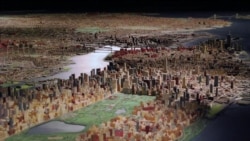Inside the Queens Museum in New York, there's another New York City, in miniature: a 50-year-old diorama of the city, built as an exhibit for the New York World's Fair in 1964.
At nearly 870 square meters, the Panorama of the City of New York is the world's largest scale-model of an urban environment. Every New York street, building, and landmark erected before 1992 is represented, from the Chrysler Building to Central Park, and all 100 or so bridges.
Visitors gawk from the surrounding ramps and balconies as day turns to night every 20 minutes, and tiny lights twinkle on - until dawn breaks again.
But the museum's central and permanent attraction also presents an unusual problem for exhibitions director and curator Hitomi Iwasaki.
"No matter what fantastic exhibition you think you put outside, everybody goes back to the Panorama and goes 'wow!'" she said.
Spectacular Panorama
For the museum's current show, marking the 50th anniversary of both the fair and the Panorama, Iwasaki said, "I decided not to compete any more, but to embrace and include the Panorama itself in the show. The exhibition's called Bringing the World Into the World, including largest and smallest collection items of the Museum. The largest one, of course, is everyone's favorite, the Panorama."
One-hundred people spent three years building the Panorama for the New York World's Fair. Visitors viewed it from a monorail ride billed as a "helicopter" tour "over" New York City. Iwasaki says the Panorama has never been moved a centimeter since then, though it is updated periodically as funds allow. The building where it was originally installed, next to another World's Fair landmark, an immense steel globe called the Unisphere, has been the Queens Museum since 1972.
For the current show, Iwasaki combined existing works and new ones, most of them sculptures or installations. "It's filled with interesting ideas about how we like to see the world, how much we like to see the world. We like to know the world by seeing," she said.
A sculpture by Beijing artist Liu Wei, for example, is a cityscape made of book pages.
"Book pages pounded, and then compressed together," Iwasaki said. "It's rather wild, almost forceful, violent piece. It talks about the craziness of development, the density and intensity of the city environment."
While it's not about any city in particular, she said, "It may have something to do with the sociopolitical climate in China in general, that books are censored and controlled very much."
Powerful forces
In another room, a sculpture by Japanese artist Hikaru Hayakawa uses copper pipes to diagram human history. Originally made as a fountain, as an on-site video shows, the horizontal pipes stand for the life-spans of nation-states and empires, while vertical tubes represent moments of conquest, war or peaceful union.
A 1983 scale model of the solar system by Chris Burden is installed with the sun hanging above the Bronx in the Panorama, and Earth, Mercury, Mars and Venus in other rooms of the museum. "Jupiter is in our next door zoo, the Queens Zoo," said Iwasaki, while Neptune is in a Mexican restaurant a kilometer and a half away.
A microscopic replica of the Queens Museum, 120 micrometers long, was made with nanotechnology by artist-engineer Jessica Rylan. It is invisible, hidden inside the Panorama's own scale-model of the museum.
"It is there, but it only exists in your imagination, believing that is there. So, that is the largest and the smallest in the show," said Iwasaki.






